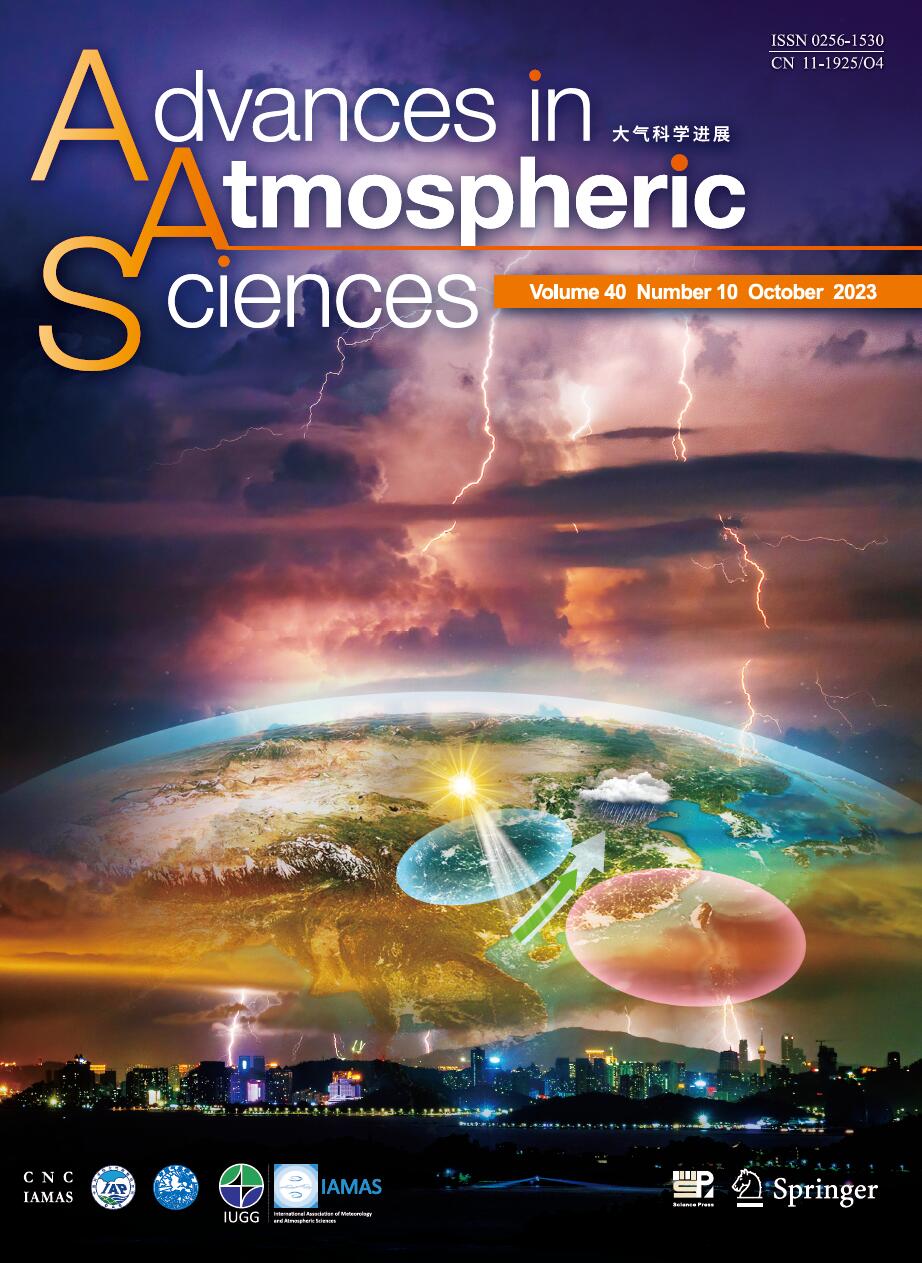| [1] |
HU Bo* and WANG Yuesi, ,
2014: Variation Characteristics of Ultraviolet Radiation over the North China Plain, ADVANCES IN ATMOSPHERIC SCIENCES, 31, 110-117.
doi: 10.1007/s00376-013-2319-5
|
| [2] |
Hui LIU, Bo HU, Yuesi WANG, Guangren LIU, Liqin TANG, Dongsheng JI, Yongfei BAI, Weikai BAO, Xin CHEN, Yunming CHEN, Weixin DING, Xiaozeng HAN, Fei HE, Hui HUANG, Zhenying HUANG, Xinrong LI, Yan LI, Wenzhao LIU, Luxiang LIN, Zhu OUYANG, Boqiang QIN, Weijun SHEN, Yanjun SHEN, Hongxin SU, Changchun SONG, Bo SUN, Song SUN, Anzhi WANG, Genxu WANG, Huimin WANG, Silong WANG, Youshao WANG, Wenxue WEI, Ping XIE, Zongqiang XIE, Xiaoyuan YAN, Fanjiang ZENG, Fawei ZHANG, Yangjian ZHANG, Yiping ZHANG, Chengyi ZHAO, Wenzhi ZHAO, Xueyong ZHAO, Guoyi ZHOU, Bo ZHU,
2017: Two Ultraviolet Radiation Datasets that Cover China, ADVANCES IN ATMOSPHERIC SCIENCES, 34, 805-815.
doi: 10.1007/s00376-017-6293-1
|
| [3] |
BAI Jianhui, WANG Gengchen,
2003: Establishing a Ultraviolet Radiation Observational Network and Enhancing the Study on Ultraviolet Radiation, ADVANCES IN ATMOSPHERIC SCIENCES, 20, 767-774.
doi: 10.1007/BF02915401
|
| [4] |
HU Bo, WANG Yuesi, LIU Guangren,
2008: Influences of the Clearness Index on UV Solar Radiation for Two Locations in the Tibetan Plateau---Lhasa and Haibei, ADVANCES IN ATMOSPHERIC SCIENCES, 25, 885-896.
doi: 10.1007/s00376-008-0885-8
|
| [5] |
WEI Ke, CHEN Wen, HUANG Ronghui,
2006: Long-Term Changes of the Ultraviolet Radiation in China and its Relationship with Total Ozone and Precipitation, ADVANCES IN ATMOSPHERIC SCIENCES, 23, 700-710.
doi: 10.1007/s00376-006-0700-3
|
| [6] |
Cheng Minghu, Shi Guangyu, Zhou Xiuji,
1990: Numerical Experiment of Combined Infrared and Ultraviolet Radiation Remote Sensing to Determine the Profile and Total Content of Atmospheric Ozone, ADVANCES IN ATMOSPHERIC SCIENCES, 7, 305-319.
doi: 10.1007/BF03179763
|
| [7] |
PENG Lichun, LI Wanbiao,
2014: Parameterizations of Surface Radiation in the Semiarid Grasslands of Inner Mongolia under Clear-Sky Conditions Using MODIS Data, ADVANCES IN ATMOSPHERIC SCIENCES, 31, 1197-1208.
doi: 10.1007/s00376-014-3215-3
|
| [8] |
HOU Jiangtao, JIA Gensuo, ZHAO Tianbao, WANG Hesong, TANG Bohui, ,
2014: Satellite-Based Estimation of Daily Average Net Radiation under Clear-Sky Conditions, ADVANCES IN ATMOSPHERIC SCIENCES, 31, 705-720.
doi: 10.1007/s00376-013-3047-6
|
| [9] |
Qiu Jinhuan,
1986: AN APPROXIMATE EXPRESSION OF THE SKY RADIANCE IN ALMUCANTAR AND ITS APPLICATION, ADVANCES IN ATMOSPHERIC SCIENCES, 3, 1-9.
doi: 10.1007/BF02680041
|
| [10] |
Nicholas EDKINS, Werner SCHMUTZ, Luca EGLI, Roger DAVIES, Teruo AOKI, Greg McFARQUHAR,
2016: The International Radiation Symposium 2016, ADVANCES IN ATMOSPHERIC SCIENCES, 33, 1325-1328.
doi: 10.1007/s00376-016-6180-1
|
| [11] |
HUO Juan, LU Daren,
2010: Preliminary Retrieval of Aerosol Optical Depth from All-sky Images, ADVANCES IN ATMOSPHERIC SCIENCES, 27, 421-426.
doi: 10.1007/s00376-009-8216-2
|
| [12] |
Mao Jietai, Luan Shengji,
1985: DERIVATION OF SCATTERING PHASE FUNCTION FROM CLEAR SKY BRIGHTNESS DISTRIBUTION, ADVANCES IN ATMOSPHERIC SCIENCES, 2, 129-131.
doi: 10.1007/BF03179745
|
| [13] |
Li Jun, Lu Daren,
1997: Nonlinear Retrieval of Atmospheric Ozone Profile from Solar Backscatter Ultraviolet Measurements: Theory and Simulation, ADVANCES IN ATMOSPHERIC SCIENCES, 14, 473-480.
doi: 10.1007/s00376-997-0065-2
|
| [14] |
HU Bo, WANG Yuesi, LIU Guangren,
2012: Relationship between Net Radiation and Broadband Solar Radiation in the Tibetan Plateau, ADVANCES IN ATMOSPHERIC SCIENCES, 29, 135-143.
doi: 10.1007/s00376-011-0221-6
|
| [15] |
GUO Xia, LU Daren, LU Yao,
2007: A Simple but Accurate Ultraviolet Limb-Scan Spherically-Layered Radiative-Transfer-Model Based on Single-Scattering Physics, ADVANCES IN ATMOSPHERIC SCIENCES, 24, 619-630.
doi: 10.1007/s00376-007-0619-3
|
| [16] |
Yunji ZHANG, Eugene E. CLOTHIAUX, David J. STENSRUD,
2022: Correlation Structures between Satellite All-Sky Infrared Brightness Temperatures and the Atmospheric State at Storm Scales, ADVANCES IN ATMOSPHERIC SCIENCES, 39, 714-732.
doi: 10.1007/s00376-021-0352-3
|
| [17] |
Zuohao CAO, Ronald E.STEWART, M.K.YAU,
2004: A New Perspective of the Physical Processes Associated with the Clear-Sky Greenhouse Effect over High Latitudes, ADVANCES IN ATMOSPHERIC SCIENCES, 21, 171-180.
doi: 10.1007/BF02915703
|
| [18] |
Jun LI, Alan J. GEER, Kozo OKAMOTO, Jason A. OTKIN, Zhiquan LIU, Wei HAN, Pei WANG,
2022: Satellite All-sky Infrared Radiance Assimilation: Recent Progress and Future Perspectives, ADVANCES IN ATMOSPHERIC SCIENCES, 39, 9-21.
doi: 10.1007/s00376-021-1088-9
|
| [19] |
Lei ZHU, Zhiyong MENG, Yonghui WENG, Fuqing ZHANG,
2022: Assimilation of All-sky Geostationary Satellite Infrared Radiances for Convection-Permitting Initialization and Prediction of Hurricane Joaquin (2015), ADVANCES IN ATMOSPHERIC SCIENCES, 39, 1859-1872.
doi: 10.1007/s00376-022-2015-4
|
| [20] |
Pak-wai CHAN, Wei HAN, Betty MAK, Xiaohao QIN, Yongzhu LIU, Ruoying YIN, Jincheng WANG,
2023: Ground–Space–Sky Observing System Experiment during Tropical Cyclone Mulan in August 2022, ADVANCES IN ATMOSPHERIC SCIENCES, 40, 194-200.
doi: 10.1007/s00376-022-2267-z
|















 AAS Website
AAS Website 
 AAS WeChat
AAS WeChat 
 DownLoad:
DownLoad: